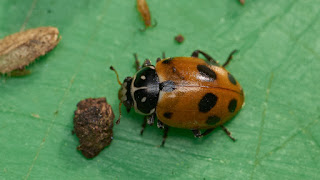What are we doing looking at a scrapyard?
Surely there cannot be anything of interest there. An even if there was, there will be nothing left at this time of the year. If you believe this do not bother reading on.
A couple of years ago Shropshire Wildlife Trust acquired Furber's Scrapyard and several fields that border Whixall Moss, Llangollen Canal and Moss Lane with the long term aim of extending the moss, providing a scrape for wintering birds and providing facilities for visitors such as a bird hide and a small car park.
The scrapyard, being a scrapyard, needed clearing of the accumulated scrap. Most of this has been done and we were granted the opportunity to go take a look.
The site looks barren.
But is it?
The site is surrounded by trees and is a neighbour of Whixall Moss. Even within the area bounded by the trees there are patches of scrubby grassland.
Is it safe?
Only a few items of scrap remain but away from the concrete areas the ground is littered with fragments of car components. And strands of razor wire can be found along the boundary.
It is safe but you must exercise caution when walking about and especially if examining things on the ground.
But what is there to find?
Well, when faced with an area apparently bereft of living things Moth Vac comes to the fore.
What did we find?
This first vacuum sample proved very fruitful.
Adonis ladybird.
 |
| Photograph: David Williams |
 |
| Photograph: Susan Loose |
 |
| Photograph: David Williams |
 |
| Photograph: David Williams |
After this we moved on to exploring the bordering trees and associated vegetation. There were a lot of alders and many were infested with the blue alder beetle Agelastica alni.
 |
| Photograph: Nigel Cane-Honeysett |
 |
| Photograph: Susan Loose |
 |
| Photograph: Susan Loose |
 |
| Photograph: Susan Loose |
 |
| Photograph: Susan Loose |
A common carder bee;
 |
| Photograph: David Williams |
 |
| Photograph: David Williams |
 |
| Photograph: Susan Loose |
 |
| Photograph: David Williams |
So, is the site barren?
I think you now know the answer to that question.
Time had marched on and lunch was taken. After lunch we visited four of the fields that the Trust has acquired but only did cursory searches for invertebrates whilst we looked at the sites and considered their potential.
In the last field we met a representative of Natural England who just happened to be there discussing work with fencing contractors. He then spent a while with us discussing the plans for the sites that we had been looking at.
Amongst the species we encountered in the afternoon were:
Two more galls, both on willow species;
 |
| Rabdophaga salicis - Photograph: Susan Loose |
 |
| Pontania bridgmanii - Photograph: Susan Loose |
 |
| Photograph: Susan Loose |
 |
| Photograph: Susan Loose |
 |
| Photograph: Susan Loose |
 |
| Photograph: David Williams |
 |
| Photograph: David Williams |
My thanks to the Shropshire Wildlife Trust for giving us permission to visit the scrapyard and fields and to the photographers David Williams, Susan Loose and Nigel Cane-Honeysett for allowing me to use their photographs.
I have one more photograph to share. A fungus - Boletus concretus!
 |
| Photograph: Susan Loose |






























No comments:
Post a Comment
Please feel free to comment on this post...